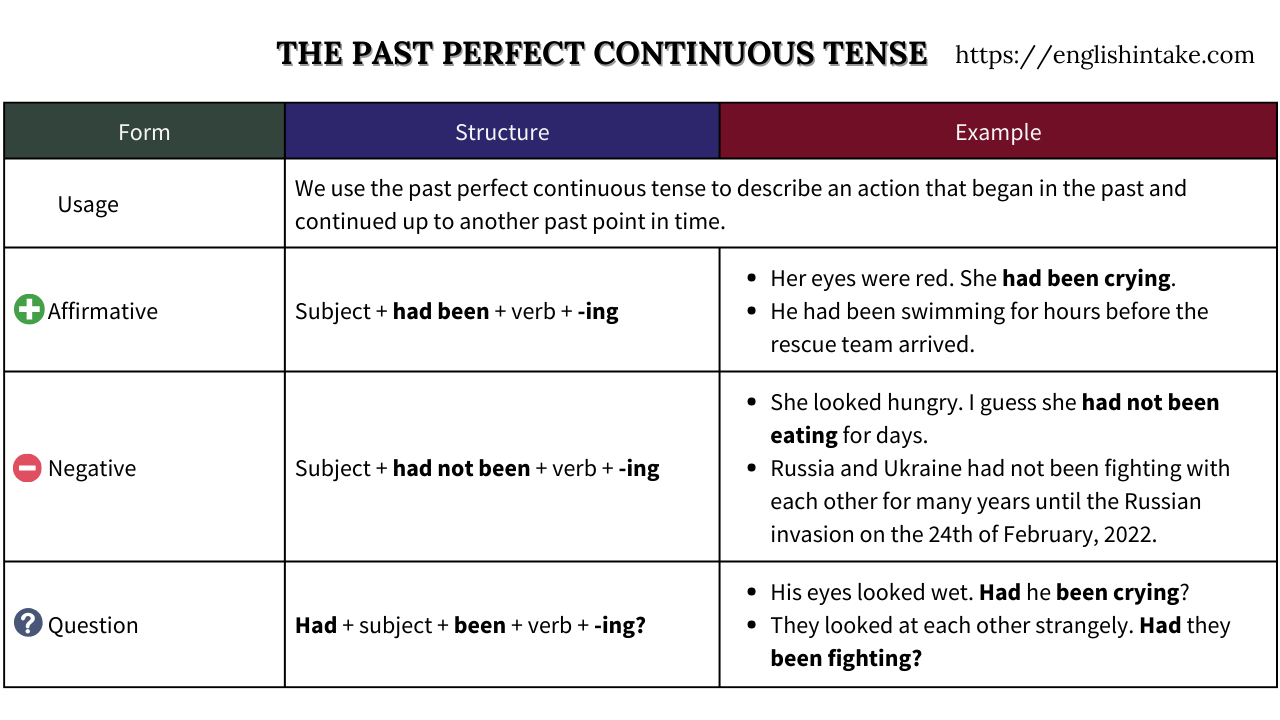1. Form of the past perfect continuous tense (or past perfect progressive)
The past perfect continuous tense is formed by using the auxiliary verb had followed by the present participle of the main verb (work => had been working).
- I had been playing
- You had been playing
- He had been playing
- She had been playing
- It had been playing
- We had been playing
- You had been playing
- They had been playing
2. Use of the past perfect continuous tense
We use the past perfect continuous tense to describe an action that began in the past and continued up to another past point in time.
1. I went to visit my sister last week. I knocked on the door, but she didn't hear it. So I opened the door, went inside and found her sitting at the kitchen table. Her eyes were red and puffy. I knew she had been crying. (She was not crying when I entered the room. But she had been crying before I went inside.)
2. Yesterday morning, I got up and walked into the living room. The room was a mess. There were empty chips, bags and cans everywhere. I was sure they had been drinking again. (Nobody was drinking when I went into the living room. But they had been drinking before.)
3. When I went to the garage this morning, I was in shock. The car was covered with mud; the license plate was missing. They had been playing off-road.
3. Past perfect simple or past perfect continuous?
Note that stative verbs are not normally used with the continuous tense. Instead, the past perfect simple is used.
✓ We had owned the house for five years before selling it.
✗ Incorrect: We had been owning the house for five years before selling it.
✓ They had known each other for many years before deciding to get married.
✗ Incorrect: They have been knowing each other for many years before deciding to get married.
✓ He had been ill for several days before he passed away.
✗ Incorrect: He had been being ill for several days before he passed away.
The past perfect simple emphasises the completion of an action, and the past perfect continuous stresses the duration of the action. Thus, we use the past perfect simple, not the past perfect continuous, to describe an action that was completed before a point in time in the past.
✓ The soldier had no more ammunition left. He had just fired the last bullet.
✗ Incorrect: He had just been firing the last bullet.
We use the past perfect continuous (not the past perfect simple) to talk about the cause of a past action.
✓ I saw dead bodies everywhere. Members of the Crip and the Blood gangs had been firing at each other.
✗ Incorrect: Members of the Crip and the Blood gangs had fired at each other.
We use the past perfect simple (not the past perfect continuous) when talking about the number of times something had been done or happened in the past.
✓Jim was fired last week. I had warned him at least five times about the consequences of his actions.
✗ Incorrect: I had been warning him at least five times about the consequences of his actions.
1. Members of the Crip and the Blood gangs had already fired at each other by the time the police arrived (here, we emphasise the fact that shots had been fired before the arrival of the police).
2. Members of the Crip and the Blood gangs had already been firing at each other by the time the police arrived (here, we focus on the duration of the action of firing).
3. Members of the Crip and the Blood gangs had already been firing at each for an hour by the time the police arrived (here, we prefer to use the present perfect continuous over the past perfect simple because we know the duration of the action).
4. Past perfect continuous or past continuous?
We use the past perfect continuous (not the past continuous) when we know the duration of the action.
✓ She had been sleeping for three hours when her phone rang.
✗ Incorrect: She was sleeping for three hours when her phone rang.
✓ She was sleeping when her phone rang (correct).
5. Learning material

